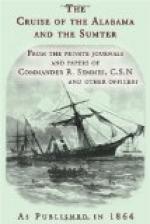Sunday, January 17th.—At daylight I sent all the prisoners on shore, where they were landed apparently in the presence of half the village—the native boats taking them through the surf—and at 9.30 got under way. The town of Angenga was formerly of some importance as a shipping port for the produce of the country—cocoa-nut oil, pepper, &c. But all its trade has passed to its more prosperous rival—Cochin. It is about fifty miles from Travancore, the residence of The Rajah. There is water communication all the way, and the journey is generally made (in canoes) in the night to avoid the heat of the sun. The natives are nearly as black as the Africans, but with straight hair and European features. A large number of them visited the ship this morning. They were fine specimens of physical development, and wore scarcely any other covering than a cloth about the loins. They were sprightly and chatty, and in their quaint canoes made quite a picture.
* * * * *
On the 17th January the Alabama left Angenga, arriving without further adventure on the 21st at the Island of Minicoy, and after three weeks more of fine weather, found herself off the island of Comoro.
* * * * *
Tuesday, February 9th.—At 3.30 A.M. passed in sight of the N.E. end of Comoro. Soon after daylight made the Islands of Johanna and Mohilla. At 1.30 P.M. came to anchor about three-quarters of a mile from the shore. Despatched the Paymaster to the-town to arrange for fresh provisions. In the afternoon visited by several canoes, with a couple of poles lashed across the gunwales, attached to a float in each, to maintain their stability. Stalwart naked negroes were for the most part their occupants. Many of them spoke a little English. Among others, a dignitary of the Church came on board with the compliments of the chief priest (Mahommedan). We made arrangements with him for the supply of the ship. One of his companions asked me to which of the belligerent parties I belonged to, the North or the South. I replied, to the South. “Then,” said he, “you belong to the side which upholds slavery.” “Yes,” said I, “we belong to the country where the black man is better taken care of than in any other part of the world.” The churchman seeing me put on the defensive, as it were, came to my aid, and said: “Oh, we are slaveholders here; being Mahommedans, we have no prejudices that way; our only trouble is, we cannot get slaves enough. The English, who have no control over us, we being an independent government, are strong enough to interfere in everybody’s business, and to say to us, that we bring over from the main no more slaves. The slaves themselves would gladly come to us, as they are much better off than under their native chiefs, who are continually making war upon and enslaving one another.”
My informant was himself a full-blooded African negro, as black as the ace of spades, but with an immaculate white turban on his head, and the flowing robe and loose jacket of the Mahommedan.




